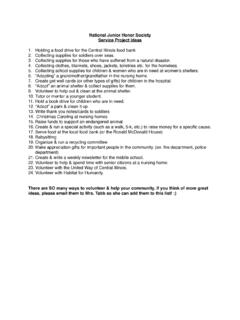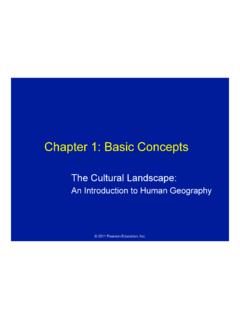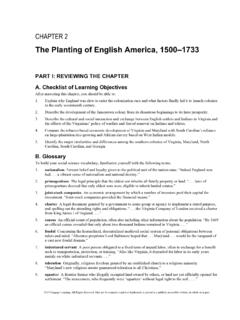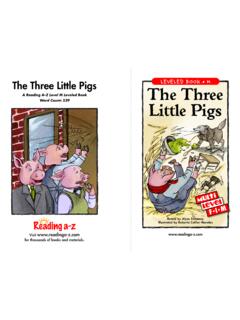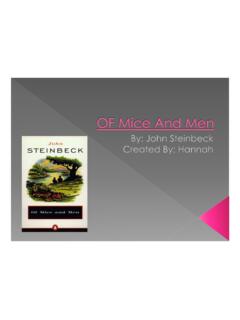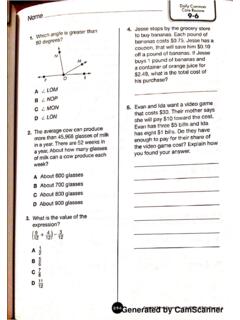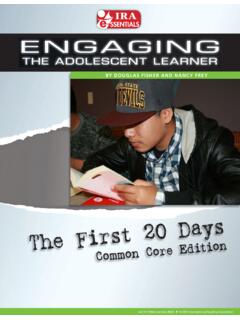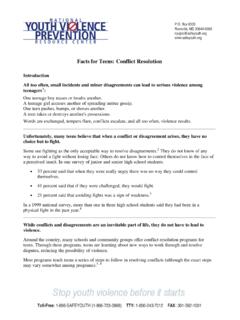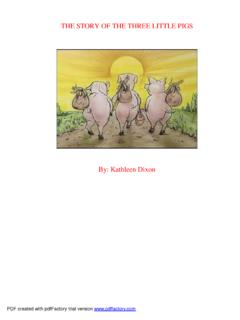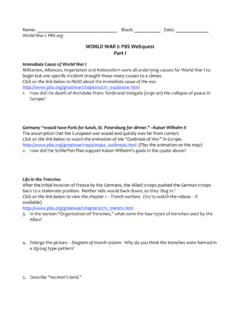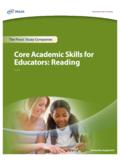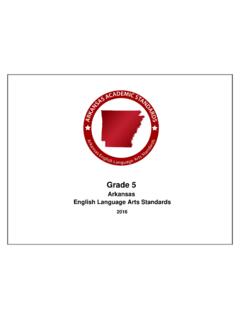Transcription of Glencoe World History: Journey Across Time
1 Blackline MasterPosterTransparencyMusic ProgramCD-ROMA udio ProgramDVDV ideocassette1 AUnit ResourcesNote:The following materials may be used when teaching Unit and section level support materials can be found on the chapter and section resource List GeneratorCD-ROMThe Glencoe BookLink CD-ROM is a database that allows youto search more than 15,000 titles to create a customizedreading list for your students. Reading lists can be organized by students reading level, author, genre, theme, or area of interest. The database provides Degrees of Reading Power (DRP) and Lexile readability scores for all selections. A brief summar y of each selection is reading suggestions for this unit:For students at a Grade 5 reading level: The Awesome Egyptians,by Terr y Dear y and PeterHepplewhiteFor students at a Grade 6 reading level: The Death of Enkidu: from The Epic of GilgameshFor students at a Grade 7 reading level: Genesis 6 9: The Flood: from the TanakhTo order this CD-ROM, call Glencoe at 1-800-334-7344.
2 Timed Readings Plus in Social Studies help students increasetheir reading rate and fluency while maintaining compre-hension. The 400-word passages are similar to those foundon state and national assessments. Reading in the Content Area: Social Studies concentrates onsix essential reading skills that help students better compre-hend what they read. The book includes 75 high-interestnonfiction passages written at increasing levels of difficulty. Reading Fluency helps students read smoothly, accurately,and expressively. Jamestown s Reading Improvement,by renowned readingexpert Edward Fry, focuses on helping build your students comprehension, vocabulary, and skimming and scanning skills. Critical Reading Series provides high-interest books, eachwritten at three reading order these products, call Glencoe at TRANSPARENCIESTEACHING TRANSPARENCIESADDITIONAL RESOURCESADDITIONAL RESOURCESW riting Process Transparencies L1 Glencoe Skillbuilder Interactive Workbook CD-ROM, Level 1 Glencoe World History Primary Source DocumentLibrary CD-ROMF ocus on World Art PrintsOutline Map Resource BookWorld Desk MapWorld Art and Architecture TransparenciesWorld Music: Cultural TraditionsWorld Music.
3 A Cultural LegacyGlencoe World Literature LibraryReading in the Content AreaTeaching Strategies for the World History Classroom(Including Block Scheduling Pacing Guides)Inclusion Strategies for the Middle School SocialStudies ClassroomUnit 1 Test Form AL2 Unit 1 Test Form B L2 DIFFERENTIATED INSTRUCTIONDIFFERENTIATED INSTRUCTIONStep Into World History Activity 1 001A-001B_U01PG_MSWHTE_60316 7/30/04 8:28 PM Page 2 Each chapter in this unit contains special reading strategies. The followingpreview will help you teach these reading skills to your :1:Get Ready to Read! Getting into a project, task, or hobby can sometimes be the most difficultpart of an otherwise enjoyable experience. In the same way, students who areasked to read a chapter without being given a preview can find the contentoverwhelming.
4 Walking students through the chapter by skimming headingsand pointing out illustrations, captions, main ideas , new vocabulary, or topicsof interest can make students comfortable with the text and better preparethem for reading. This skills spread will teach students how to skim the basiccomponents of the :2:What Do You Predict?When students learn to predict what is coming next in a text, they becomeactive participants rather than passive observers in the process of students make predictions, as they read silently and as they discussthe content, engages their cognitive processing in ways that will have long-term positive effects on their abilities to comprehend and remember whatthey have read. Predictions can be in the form of questions, hypotheses, antic-ipation guides, or small group discussions.
5 This exercise teaches students tomake predictions based on the main Ideasfound in each :3:Finding the main IdeaAs students develop skimming and previewing skills, they will be preparedto engage the text more actively. The next step in the process of understand-ing textual content is to determine the purpose for a given paragraph, or find-ing the main idea. This skills spread will teach students that main ideas arethe most important ideas in a paragraph, section, or chapter . Supportingdetails further develop the main idea by providing facts or examples. Theexercise will demonstrate how to visually organize main ideas and support -ing details through graphic organizers. Use the SkillBuilder Handbookon pages 902 919 to help students practice important 9/9/04 6:49 PM Page 3 UUNITNITOOVERVIEWVERVIEWUnit 1 starts with early humansand traces how they studying this unit, stu-dents should be able the impact of farm-ing on the development ofearly civilizations; the development ofEgypt s empire; important events inthe history of civilization that you will study in this unit madeimportant contributions to history.
6 The Mesopotamians developed writing. The Egyptians created papyrus. The Israelites scripture influenced the religions of standsbefore a godEarlyCivilizationsFirstCivilizationsF irstCivilizationsChapter1 AncientEgyptAncientEgyptChapter2 AncientIsraelitesAncientIsraelitesChapte r3c. 1790 intro-duces code of lawsc. 5000 settleNile River valleyc. 2540 complete building of GreatPyramidc. 1500 pharaohc. 2000 enters CanaanPyramids at Giza, Egyptc. 8000 begins insouthwest AsiaAbraham leadsIsraelites to Canaanc. 3200 inMesopotamiadevelop writing(t)Reunion des Musees Nationaux/Art Resource, NY, (c)John Heaton/CORBIS, (b)Tom Lovell/National Geographic Society Image CollectionIf time does not permitteaching each chapter in thisunit, you may use theReading Essentials andStudy students to the multiple-tier time line on these pages.
7 Explain that it tells when differentempires in different places thrived. Ask volunteers to come to the World map and take turns locating each of the places identified on the time line as other students point out the location on the maps in their texts. Point out that civilizations grew around the same time in different places around the LINE ACTIVITYTIME LINE ACTIVITYINTRODUCINGUNIT1 INTRODUCINGUNIT1 Explain to students that all civilizations both past andpresent have certain things in common. For example, alldeveloped governments tohelp meet the needs of theirpeople. Discuss with studentsthe needs addressed by gov-ernments today. Ask whetherstudents think governmentswould have provided the sameservices thousands of yearsago. L10000-0003_3937 4/19/04 12:06 PM Page 981000 100 1000 100 NSWE1,000 km0 Mercator projection1,000 E30 E0 90 EEQUATORRedSeaPersianGulfBlack SeaINDIANOCEANC aspian 2 chapter 2 chapter 3 chapter 3 chapter 1 chapter 1c.
8 1000 David rules Israelc. 612 captureAssyrian capitalc. 1000 breaks free of Egypt728 conquersEgypt168 70 Romansdestroy templein JerusalemJews ledinto exileKushite king Taharqa chapter 1 chapter 2 chapter 3 Ancient Jerusalem c. 744 expandsinto Babylon1 Hanging gardens of Babylon586 statue honoring Kushite king Aspalta(tl)Brooklyn Museum of Art, New York/Charles Edwin Wilbour Fund/Bridgeman Art Library, (bl)Erich Lessing/Art Resource, NY, (others)SuperStock1 World HistoryPrimary SourceDocument LibraryCD-ROMUse the World History PrimarySource Document Library CD-ROMto access primarysource documents related to theworld s first TipThe goals of theNCLB Act include a strongemphasis on reading. Usingmodeling in your class willhelp students become betterreaders.
9 For example, pointout to students that thereare many vocabulary termsin the first section of thisbook. Read aloud a sentencecontaining a vocabularyterm. Then demonstratehow to use other words in asentence as clues to themeaning of a new the model by ask-ing volunteers to read aloudother sentences containingvocabulary terms. Ask eachvolunteer to think aloud ashe or she uses the context todetermine a possible mean-ing for the vocabulary Learners:To help students understand that important events occurred around the World at the same time, have them make a list of all the events on the time line by breaking them into 200-year intervals. Rather than group them by civilization, have students group them by :Have students take a simple outline map of the region covered in this unit.
10 Then havethem mark the time line events on the map to illustrate where they took and Talented:Have students research several events on the time line from different have them write a short description of each event and present it to the INSTRUCTIONDIFFERENTIATED INSTRUCTION000-003_UI01_MSWHTE_60316 8/4/04 11:52 AM Page 1 The unit preview provides ageneral layout of the regionsand significant figures in students to answer the following questions using major bodies of waterare shown?(MediterraneanSea, Black Sea, Red Sea,Caspian Sea, Persian Gulf) continents arelabeled?(Africa, Asia)2 Ruled c. 1792 1750 kingChapter 1, page 22 Ruled c. 1503 1482 pharaohChapter 2, page 63c. 3300 found in the Alps chapter 1, page 12 AFRICAAFRICARedSeaMediterranean SeaIshtar Gate1 See First CivilizationsChapter 1 Sumerian figures2 See First CivilizationsChapter 15342 INTRODUCINGUNIT1 INTRODUCINGUNIT1 PPREVIEWINGREVIEWINGAsk students the followingquestions using the of the people pic-tured ruled Egypt?
